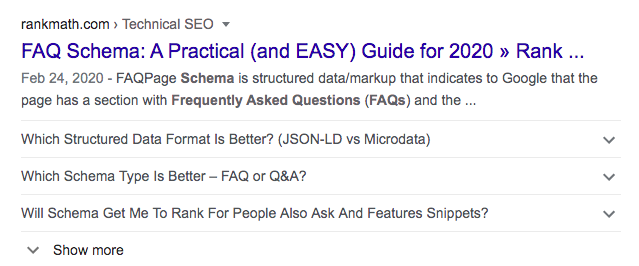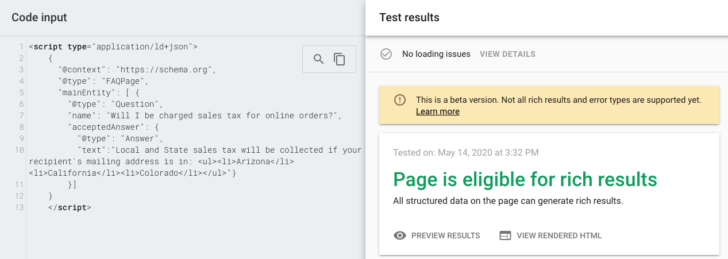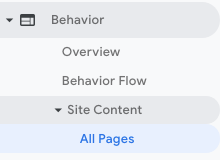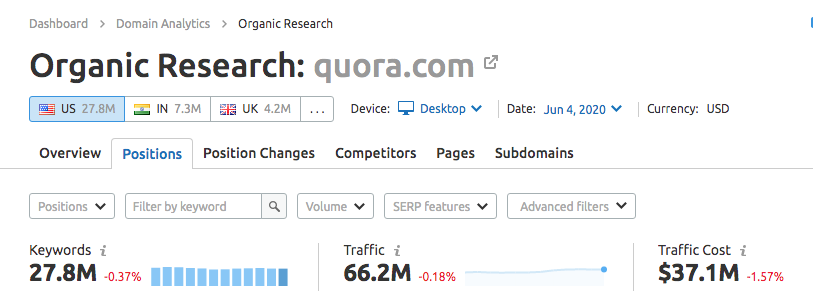30-second summary:
- SEO has evolved to cover a wide range of efforts that contribute to traffic generation.
- The easiest way to improve search visibility is to have an arsenal of tactics at your disposal for creating a top-ranking page.
- Improving the quality of content and backlinks are prime ranking factors that influence the placement of a page in a search result and can be done in a variety of ways.
- Founder of Digital Ducats Inc, shares in detail 10 different advanced SEO tactics to drive traffic by improving the quality of the content you’re publishing for users.
Learn how to drive more traffic to your website and you will have learned how to ensure the growth of your business. Driving more relevant traffic is the overarching goal of every website owner that wants to increase revenue.
The success of your website relies on the volume of relevant traffic that you’re able to generate on a regular basis. Here are 10 advanced SEO tactics to increase the traffic to your website on a regular basis.
1. Increase content production
Did you know websites that publish SEO optimized blog posts two-to-four times a week produce the highest number of leads and conversions? Increasing your content production allows your website to expand the range of keywords it targets and provides more answers to the questions people are searching for.
The frequency of the content you create should align with the goal you’ve created in your overall content strategy. Neil Patel had the goal of increasing his page views to hit 100k.
When he was publishing once a week his views were at 46k page views. After increasing his content production to twice a week he was able to hit 100k page views in under a year.
Don’t mistake frequency as the only factor that will improve your website traffic. Learn how to write articles for marketing to build trust and accumulate backlinks.
Aim to publish informative articles and provide value to your audience. According to Conductor, even a week after reading educational content, people are 48% more likely to buy from the company that educated them.
Pumping out low-quality blog posts that lack quality will eventually hurt your website. Publish content with the intention of providing solutions to problems and relevant questions.
2. Cluster your content to drive more traffic
A web page ranking is highly influenced by the topical relevance of the page to a search query. Google favours sites that demonstrate Expertise, Authority & Trust (E.A.T.). This makes establishing topic clusters using pillar page best practices ideal for driving more traffic.
A topic cluster consists of pillared content (central keyword theme) and clustered content (articles with a narrow focus).
The pillar pages are typically long-form and cover a broad keyword topic. Pillar pages link to clustered content to go deeper into detail about more specific topics that share the central keyword theme.
The clustered content links back to the pillar page, lifting the authority of the pillar page which highlights its importance. Clustered content will also link to other clustered content on relevant topics.

This internal linking strategy strengthens the topical relevance of your pages and contributes to improved ranking, increased traffic and higher click-through rates.
Tips for creating effective topic clusters
- Select well-researched keywords to create the most effective topic clusters. Target long-tail keywords in your clustered content to lower competition and drive traffic that is a better match to your website.
- Publish 10X content that solves a specific problem to rank highly and be the best solution in a search result.
- Perform a content audit to make sure you use existing content to target keywords in your cluster and avoid keyword cannibalization.
3. Optimize for featured snippets
Featured snippets appear for just about every question that is searched on Google. Drive more traffic using pages on your site that already rank on the first page of Google.
According to a study by Ahrefs, if your site is featured in the snippet (also referred to as position zero) it adds an additional 8.6% of the available traffic to your site.
Identify every keyword that your site ranks for on the first page. You can use Moz, SEMRush, or Ahrefs or any keyword-tracking tool to get a list of your first page appearances.
Keep in mind that with the new format, if your site is in the number one position, there is some debate on which position is more valuable in terms of traffic.
Tips to win position zero
- Duplicate the current snippet’s optimization.
- If there’s a paragraph answer, provide a paragraph answer immediately after your featured snippet heading. The sweet spot is between 40-60 words.
- If there’s a list featured, use the HTML for an ordered list
- Use title tags for the question or title that represents the snippet.
- Use title tags for subtitle headings that Google could possibly use as a list.
4. Add FAQ structured data markup to performing pages
Google introduced FAQ structured data markup that shows up as a rich result. You can use FAQ schema to increase the click-through rate that your page receives. The rich result displays each of the questions you have listed in an interactive drop-down styled format.

This can be useful to sites for increasing the click-through rate because of the extra space that is being taken up by the SERP result.
You can use the following markup found on Google’s developer reference page to make your FAQs eligible to show up as a rich result.
You can also test the markup to make sure it works:

Tip for adding FAQ schema
If you’re using Yoast, it has a feature specifically for adding these to your content. It can save you the time of cutting and pasting code to your content.
- Target the PAA box by publishing a FAQ page: The PAA box (People Also Ask) requires similar optimization to the featured snippet. The PAA box can drive additional traffic when users click through to your site. Increase the likelihood of being featured by publishing a Frequently Asked Questions page.
- Research commonly asked questions: Research the questions that are appearing in the top 3 or 4 spots in the PAA box. Click on any relevant questions that you will use on your FAQ page. Every time you click a question you should get another three or four questions that are added to the bottom of the box.
- Optimize your answers: The first paragraph answer you provide should be roughly 50 words in length. Use the Inverted Pyramid style of writing to improve the likelihood of your answer being selected. Give people what they need to know in the first paragraph and what is nice to know afterwards
Tips for driving more traffic from the PAA box
- Never use one-sentence answers as responses. Make each response to a question detailed enough to be a complete answer.
- Provide links to relevant content within your site to promote a higher CTR.
- Enhance optimization with jump links at the top of the page. Not only does this improve the UX (user experience) but it also helps search engines locate specific content on your page.
How to create a jump link
The HTML of a jump link can be implemented using the following code:
Choose a name to use as the link ID. In this example, the link ID is “jump”. Use the following HTML code to add the link to your questions at the top of your page:
<a id=”jump”>Question and answer you want to jump to</a>
Next, you will need to place the code for the linked target before the beginning of your answer in order to take users directly to that spot on your page:
The HTML code for the linked target is: <a id=”jump”></a>
Alternatively, you can insert the answer within the code as the linked target:
<a id=”jump”>ANSWER</a>
5. Repurpose top-performing content
Use the top-performing pages on your site to create new variations of the same content. By creating a new version of popular content you’re guaranteed to spark interest and encourage more traffic.
Identify the pages that receive the most traffic on your site. You can do this by checking Google Analytics. On the left navigation panel, click on the following: Behaviour > Site Content > Pages.

The report will give you a break down of the volume of page views and the time spent on the most popular pages.
Select the period of time you want to compare pages (six months to a year).
Make your decision based on the pages that attracted the most clicks and that people spent the most time on.
You can take any blog article and create an infographic, video or slide presentation in order to mix things up.
Use your new multimedia such as a video or slide presentation to post to external sites and social media to generate new streams of traffic.
6. Guest post on healthy relevant websites
Backlinks fuel the ranking ability of your content. Good content attracts backlinks, however, if you don’t want to wait around for links to appear, you need to take action.
Use guest posting as a strategy to build links to internal pages on your site to create more entry points for visitors to find your content (referral traffic).
Building links from high traffic websites earn streams of targeted traffic as well as a boost in authority and credibility by linking to your content.
The links you receive from guest posting are contextual, which is considered the best type of link. Include links to relevant content on your site within the article to provide your reader with a reference that enhances their experience.
Tips for guest posting
- The most ideal sites to guest post on are healthy, authoritative and have high subscribership for referral traffic.
- Topical relevance is key in providing the most impact on links you point to your site. Link to content that enhances the user experience.
- Create alliances with authors or websites to scale up your efforts. If you include a link in your content to a partner’s site, and they do the same for you-your efforts are doubled with every article you publish.
7. Build your local presence
Drive more local traffic by brushing up on the essentials of local SEO. Ask clients for reviews, keep your NAP details consistent and your GMB profile updated and accurate. One of the most powerful tactics that will help surface your website in localized searches is acquiring local backlinks.
Apart from the common places to link from, such as structured citations (directories, review sites, profile links, etc.) aim for unstructured citations on local business blogs.
12 Web Design Trends by Toronto Experts is an example of an infographic that was used in a local outreach campaign. This local SEO strategy combined an expert round-up with an infographic to result in a 63.64% increase in traffic to local landing pages.
Add the fact that infographics generate 172% more backlinks than your typical blog post, and there’s a pretty convincing argument to incorporate them into your local link building strategy.
8. Become an expert on Quora
Quora is a site that gets over 300 million unique visitors every single month. There are loads of questions that are asked on a daily basis that fall into your area of expertise. If you consistently answer a few questions a day, you can build a reputation that ultimately leads to referral traffic.
All links on Quora are no-followed but you can still leverage the opportunity to send people to your site with high quality, in-depth answers. The idea is to go above and beyond the quality of a standard response to get your answer upvoted.
The answer with the most upvotes will float to the top of the answers. This means when other people search the question, your answer will be the first one they see.
If it’s really good, it should also be the last one they see.
9. Use the Barnacle SEO method
Where you can take your traffic generation to another level is to combine Quora’s traffic with the traffic from Google search. There are literally hundreds of thousands of questions that Quora ranks for on the first page of Google.
Not only can your answer receive thousands of views from Quora, but you’ll also get users to find your answer on Google as well.
You can use tools like SEMRush to get a list of the keywords Quora ranks for and filter the results to search for your keywords in the top ten organic results.

Tips for getting more referral traffic from Quora
- When choosing questions to answer, look for the ones that already have a high number of followers. The number of followers on each question will mean they will be notified every time the question receives a new response. Choose questions with a minimum of 15 followers to guarantee a decent-sized audience as a long-term strategy.
- Optimize your profile by including a detailed bio with a link to your website. When users read the answers you’ve provided, they will want to know more about you. Don’t disappoint them by leaving a blank bio with no way of getting to your site.
- Too many self-promotional calls to action may put your account at risk. Users get suspended and even banned from Quora for leaving affiliate links or too many links that lead people off-site.
10. Invite guest authors
Inviting authors to write an article on your site is a great way to spice up your content with a fresh perspective. Publishing articles from guest authors contribute to increased content production, attract a new audience and backlinks.
Increased focus on topic coverage
Your content production increases with submissions from guest authors. This can allow you to focus more on the topics your blog is covering and the keywords you’re targeting. The added depth to your content production will contribute to an increase in traffic.
Attract a new audience
Authors who are publishing regularly share their content with their network. This brings a whole new audience to your site.
Most authors share their published work with their social network or even on their own website. This can be worth a nice addition of new visitors if you have a contributing author with a large network.
Acquire more backlinks
It’s common practice for a regular blogger to reference a previously published article with a link. If your contributors are publishing regularly on other sites you should inevitably acquire a few links you wouldn’t have received otherwise.
Create a “write for us” page
Create a page on your site that invites authors to contribute. Use “write for us” in the URL and title. Guest bloggers use that phrase to find sites to contribute articles.
Define your requirements for posting on your blog to give contributors an idea of what is expected to get an article approved.
Recruit your writers
Reach out to writers that are regularly publishing content in your niche. Whenever you read a good article on a topic that’s relevant to your site, make the connection and invite them to write for you. Most authors leave a link to their site or social media or website so it isn’t too difficult to make contact.
Explore, experiment and do what works for you
There are so many ways to drive traffic to a site that it’s worth exploring new options and experimenting with new tactics to see what works for you.
Whichever advanced SEO strategy you use, make sure you give it a fair shot by seeing the process the whole way through.
Thre’s a learning curve to every new tactic but you’ll learn the most through personal, hands-on experience. Whenever something works, stick with it and scale-up. You now possess the knowledge of using 10 different strategies to drive more traffic to your website.
Choose wisely and drive safely. 
Christian Carere is an SEO consultant and the founder of Digital Ducats Inc. He can be found on Twitter @DigitalDucats.
The post 10 Advanced SEO tactics to drive more traffic to your website appeared first on Search Engine Watch.
from SEO – Search Engine Watch https://ift.tt/30kzTL5
via IFTTT


No comments:
Post a Comment